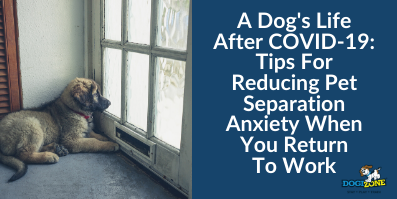A Dog’s Life After COVID-19: Tips For Reducing Pet Separation Anxiety When You Return To Work
Dogs with pet separation anxiety have genuine emotional and distress reactions when separated from their families. These distress reactions can include destructive behaviors such as digging, chewing, or soiling in the house, and they often include excessive barking or howling when the dog is alone. Dogs can also pace or bite, lick, or chew on their paws or areas of the body as a sign of stress.

With many people across the country working from home, dogs with separation anxiety spend all day at home with their families. At this time, being with people all day may seem extremely positive for all dogs and pets. However, for those with pet separation anxiety, it is creating a potential disaster when kids return to school and adults return to their workplace.
To assist your dog in adjusting, it is vital to start taking action now. Adjusting your schedule and routine to more closely mimic an average day when the dog is left alone is crucial to begin to prepare your pet for the return to a typical schedule.
Routines are Crucial
Dogs thrive on routine, and for dogs with social anxiety, the routine should focus on people leaving and coming back home. It means the people in the family need to follow a normal morning preparation routine. The routine allows the dog to understand that leaving is a regular activity that is followed by the family returning.
Keep your morning routine as close as possible to a typical day when you leave the house for work. Get up at the same time, have a shower, eat breakfast, and then go to the door, put on a coat, pick up the car keys and follow your usual pattern of behavior.
Crating or Confinement
For most dogs with pet separation anxiety, crating or confinement is a part of their routine. If the dog is normally crated or put in a specific room when you leave the house, continue with this routine. Makes sure to provide the dog with the toys, fresh water, and any favorite items as usual.
While it may seem counterintuitive to confine, crate, or isolate the dog when you are working at home, it is the routine that is comfortable and understandable for the pet. Keeping the dog with you or the family 24/7 is only going to make the change back to being alone in the house more difficult for the dog in the upcoming weeks.
Of course, it is great to be able to take the dog out for walks, playtime, and interaction throughout the day. Just keep in mind the crating or being in a comfortable, familiar space while you are working from home is part of the process of adjusting to your absence in the future.

